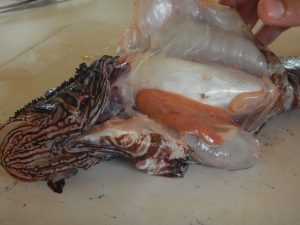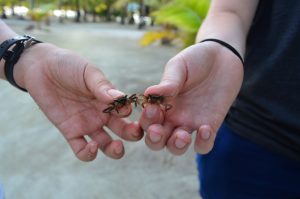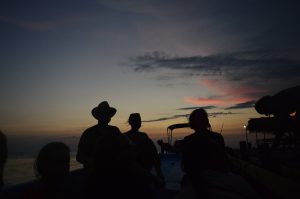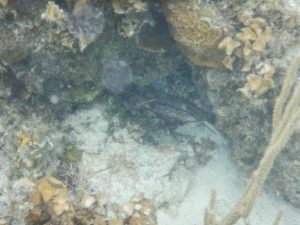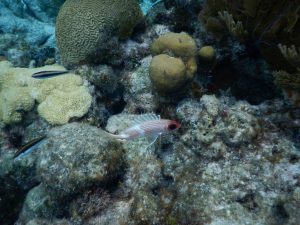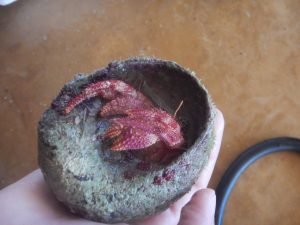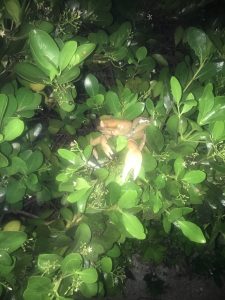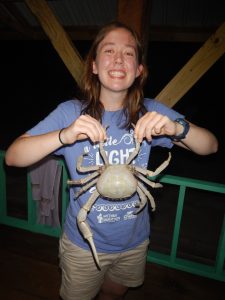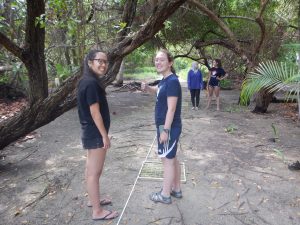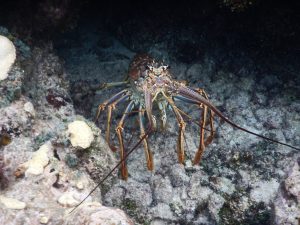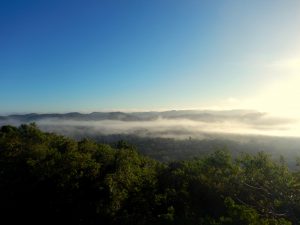Now I’m back home, enjoying air-conditioning and incredibly fast image upload speeds to the blog, but missing the beauty of the tropics. A sea of identical suburban rooftops just doesn’t compare to the actual sea.
The rainforest and the reef are two extremely diverse ecosystems despite their low nutrient availability (like I talked about for my lecture on rainforest soils). Because nutrients are hard to come by, organisms are able to fill many different small niches where nutrients are more available. In addition, neither of these ecosystems are low energy. Their proximity to the equator means they have lots of solar energy pumping in all year long. That light is converted into more accessible energy by plants in both ecosystems. One striking similarity that I noticed in both of these ecosystems is that, despite their extreme diversity, seeing moving animals is surprisingly difficult. As you walk through the rainforest, you see very few mammals or reptiles or birds, a good number of insects, but still surprisingly few. The same was true for the reef, the fish and crustaceans and echinoderms blend in so well you often can’t see them.
Overall, this course was everything I expected and more. I came in with a vague expectation to do a little research and learn about the environments we would be surrounded by. I didn’t expect to be designing, implementing, and presenting experiments all in the same day. I also hadn’t even thought to expect how much fun this trip was. My favorite part of the course was definitely hiking through the rainforest and finding insects I knew a surprising amount about despite having never seen them before. I hadn’t realized that because I knew a good bit about one insect species I study at school I could extend that knowledge to related insects I’d never even heard of. (Hemipterans are dope!) My least favorite part of the course was swimming through the reefs. The reefs were absolutely amazing to look at, but I was always afraid of damaging everything around me. The coral reefs are famous for being in danger and as we snorkeled through them I often felt like touching anything might destroy everything. Sometimes swimming through the reefs I worried that we were doing more harm than good. The fish and the corals were beautiful and I don’t want to do anything to hurt them.
The three most important things I learned in this course were how specific knowledge can become general knowledge, how little we actually know about both of these ecosystems, and how important these ecosystems are and how closely linked they are to the entire world. I’ve already talked about the first one a little bit but finding two true bugs nobody recognized and being able to identify that they were nymphs and recognize their body plan was crazy. I could look at these two bugs and I knew what body parts to measure to quantify their size because I’d measured something similar many times before. It was really cool to see the effects of common ancestry implemented. The second thing I realized as we were all trying to identify our species. In the rainforest with birds, pretty much everything was identified, but many of the insects had little to no information available. Most of the taxon id cards featured genera at best and the books we had on tropical insects focused almost exclusively on butterflies, despite the broad diversity of everything else. In the coral reefs, I struggled to find information online about shrimp and crabs and was unable to identify plenty of organisms because they were small or because I didn’t have the right books or because they simply weren’t really described anywhere. Because these two ecosystems have so much diversity and because many of these organisms are so well hidden, information is often inaccessible unless you are an expert in a very specific field, if the information exists at all. The last of the three big things I learned is how both of these ecosystems are closely linked to everywhere else. From the reading before the course, we learned that the xatè palm is harvested from the Chiquibul forest to be used in flower arrangements. From the experiment we did with trash and from Andressa’s presentation, we learned that trash from all over the world can get moved by the wind and water and wind up in the ocean. While we are often unintentionally doing these (and many other) harmful things to the tropics, the tropics are doing surprisingly important things for us. The rainforest is an important CO2 processor and a source of many medicines. The coral reefs act as nurseries for fish that spend their adult lives all across the oceans. Without either of these ecosystems, humans would be worse off and the world would be less beautiful.
Now that I’m home, I get to reminisce about the great experience I just had and implement my new found knowledge and understanding.


